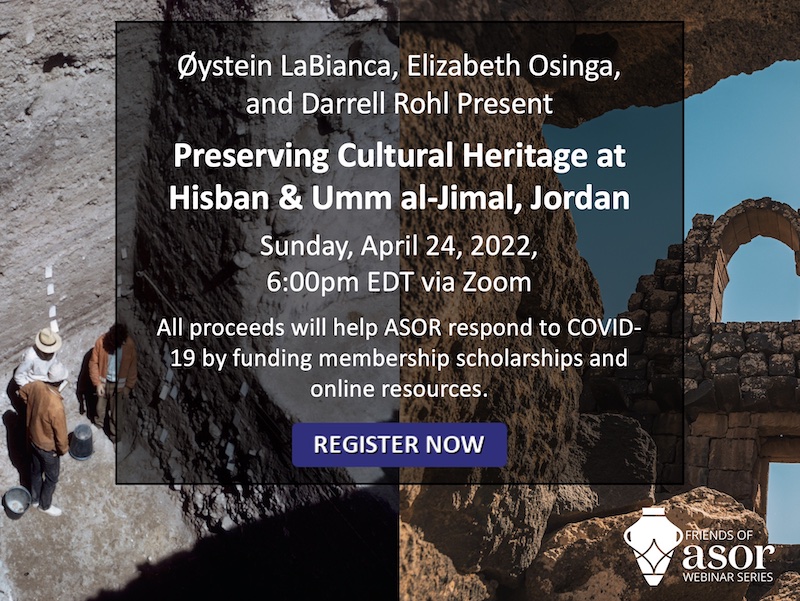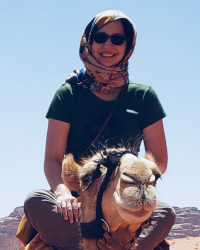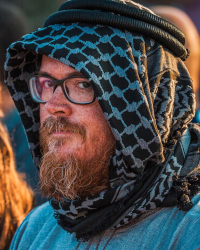FRIENDS OF ASOR WEBINAR
Preserving Cultural Heritage in Hisban and Umm al-Jimal, Jordan
6:00pm – 6:30pm
Øystein LaBianca
Andrews University
Jordan: Hisban (part of the Madaba Plains Project)
Tall Hisban stands as a witness to global history and a window on daily life in Jordan through the ages. Here excavators have unearthed traces of multiple civilizations and empires; a thriving market town from the time of the Assyrians, Babylonians, and Persians; large quantities of amphora jars containing tiny fish bones attesting to strong local demand for garum—a fermented fish sauce condiment that was an essential flavor in ancient Greek and Roman cooking; the expertly shaped masonry foundations of a Roman public building; the apse, pillar foundations and partial sections of several mosaic floor panels of two Byzantine basilica churches; and the private residence and bath (Hamam) of the Mamluk governor of this part of Jordan during the 14th century AD. Just as important are evidence of daily life through the ages attested in the large number of pots used for storing and preparing food; the thousands of skeletal fragments of sheep, goats, cattle, horses, mules, poultry, and even fish; and the use and re-use of domestic buildings, courtyards, water channels, and cisterns. A major focus of the 2022 field season will be to explore connections between Greco-Roman Hisban (Esbus) and the cities of the Decapolis. Click here for a short film about the history of the Madaba Plains and click here for a short film on the discoveries at Tall Hisban.
6:30pm – 7:00pm
Darrell Rohl
Calvin University
Elizabeth Osinga
Umm al-Jimal Archaeological Project (UJAP)
Jordan: Umm al-Jimal Archaeological Project (UJAP)
Umm al-Jimal is the best-preserved example of a Late Antique town within the southern Hauran region of Jordan and Syria, featuring the upstanding ruins of more than 150 individual houses, nearly twenty places of worship representing paganism, Christianity, and Islam, as well as large imperial military and administrative structures, and community infrastructure of roads and water management, all enclosed within an intact ancient town wall. Previous archaeological fieldwork has focused on documenting the upstanding remains with limited excavation in order to answer specific research questions. In recent years, the site’s churches have become a particular focus of excavation activity, seeking a better understanding of the relationship between religious practice and domestic life across the site. The 2022 field season will continue this research focus, with a new open-area excavation methodology centered on the enclosed temenos/churchyard of the site’s extramural West Church, including within ancillary rooms attached to the church’s east end. Further fieldwork activities at the site will include on-the-ground inspection and documentation of 30+ potential structural features that have been identified from recent aerial photographs. In addition to fieldwork, there are several ongoing heritage-focused projects: completion of the Interpretive and Hospitality Center and the archaeological park; training of local guides and excavators; continued partnership with the local non-profit, Hand By Hand Heritage; and the completion of Umm al-Jimal’s UNESCO World Heritage Nomination file.
7:00pm – 7:30pm
Audience Q&A with all Panelists
Sponsors will be acknowledged during the event. Sponsorships are available at the following levels:
- Bronze Sponsor: $50 (includes 2 gift registrations to share)
- Silver Sponsor: $100 (includes 5 gift registrations to share)
- Gold Sponsor: $500 (includes 15 gift registrations to share)
- Platinum Sponsor: $1,000 (includes unlimited gifts registrations to share)
Each sponsor will receive a confirmation e-mail. If you do not receive this e-mail, then we did not receive your sponsorship online. If you prefer to register or sponsor over the phone, please call 703-789-9230. Please e-mail membership@asor.org with any questions or issues.
Speakers / Presenters
ASOR is grateful for your support. Each registrant will receive an automated confirmation e-mail. If you do not receive this e-mail, please check you Spam folder and then contact ASOR. If you prefer to register over the phone, please call 703-789-9230. Please e-mail membership@asor.org with any questions or issues.






 Øystein LaBianca is a Professor of Anthropology in the Department of Behavioral Sciences and Associate Director of the Institute of Archaeology at Andrews University. He is the Senior Director of the Hisban Cultural Heritage Project, a community archaeology project centered at Tall Hisban in Jordan. He holds a Ph.D. in cultural anthropology and archaeology from Brandeis University. LaBianca’s research in Jordan began with studies of long-term human-animal-environment interactions as evidenced by changes over time in animal bone assemblages and related finds uncovered by his excavations and surveys at Tall Hisban. He has also been a leader in introducing community archaeology approaches to archaeological projects in Jordan. He is a long-time member of the boards of trustees of ASOR and ACOR in Amman, Jordan.
Øystein LaBianca is a Professor of Anthropology in the Department of Behavioral Sciences and Associate Director of the Institute of Archaeology at Andrews University. He is the Senior Director of the Hisban Cultural Heritage Project, a community archaeology project centered at Tall Hisban in Jordan. He holds a Ph.D. in cultural anthropology and archaeology from Brandeis University. LaBianca’s research in Jordan began with studies of long-term human-animal-environment interactions as evidenced by changes over time in animal bone assemblages and related finds uncovered by his excavations and surveys at Tall Hisban. He has also been a leader in introducing community archaeology approaches to archaeological projects in Jordan. He is a long-time member of the boards of trustees of ASOR and ACOR in Amman, Jordan. Elizabeth Osinga is currently working full-time as a co-director of the Umm al-Jimal Archaeological Project (UJAP). A former student of the late UJAP director Bert de Vries, she has worked with the project since 2012 and her graduate work focused on a socio-economic approach to ceramic analysis at the site (University of Southampton, MA, PhD). When not involved in excavations, grant writing, or other essential projects, she is immersed in Umm al-Jimal’s archive, analyzing the backlog of excavation reports and materials in preparation for long-overdue publication.
Elizabeth Osinga is currently working full-time as a co-director of the Umm al-Jimal Archaeological Project (UJAP). A former student of the late UJAP director Bert de Vries, she has worked with the project since 2012 and her graduate work focused on a socio-economic approach to ceramic analysis at the site (University of Southampton, MA, PhD). When not involved in excavations, grant writing, or other essential projects, she is immersed in Umm al-Jimal’s archive, analyzing the backlog of excavation reports and materials in preparation for long-overdue publication. Darrell Rohl is an Assistant Professor of Archaeology, History, and Digital Humanities at Calvin University and is a co-director of the Umm al-Jimal Archaeological Project. A graduate of Andrews University (BSc) and Durham University (MA, PhD), his research has primarily focused on Roman and Late Antique periods in England, Scotland, and Jordan, as well as the application of place theories in archaeological and heritage contexts. He has co-directed excavations with Dr. Elizabeth Osinga at the Hisban North Church (2018) and Umm al-Jimal (2019), and has further fieldwork and research experience in the UK, USA, and Italy.
Darrell Rohl is an Assistant Professor of Archaeology, History, and Digital Humanities at Calvin University and is a co-director of the Umm al-Jimal Archaeological Project. A graduate of Andrews University (BSc) and Durham University (MA, PhD), his research has primarily focused on Roman and Late Antique periods in England, Scotland, and Jordan, as well as the application of place theories in archaeological and heritage contexts. He has co-directed excavations with Dr. Elizabeth Osinga at the Hisban North Church (2018) and Umm al-Jimal (2019), and has further fieldwork and research experience in the UK, USA, and Italy.